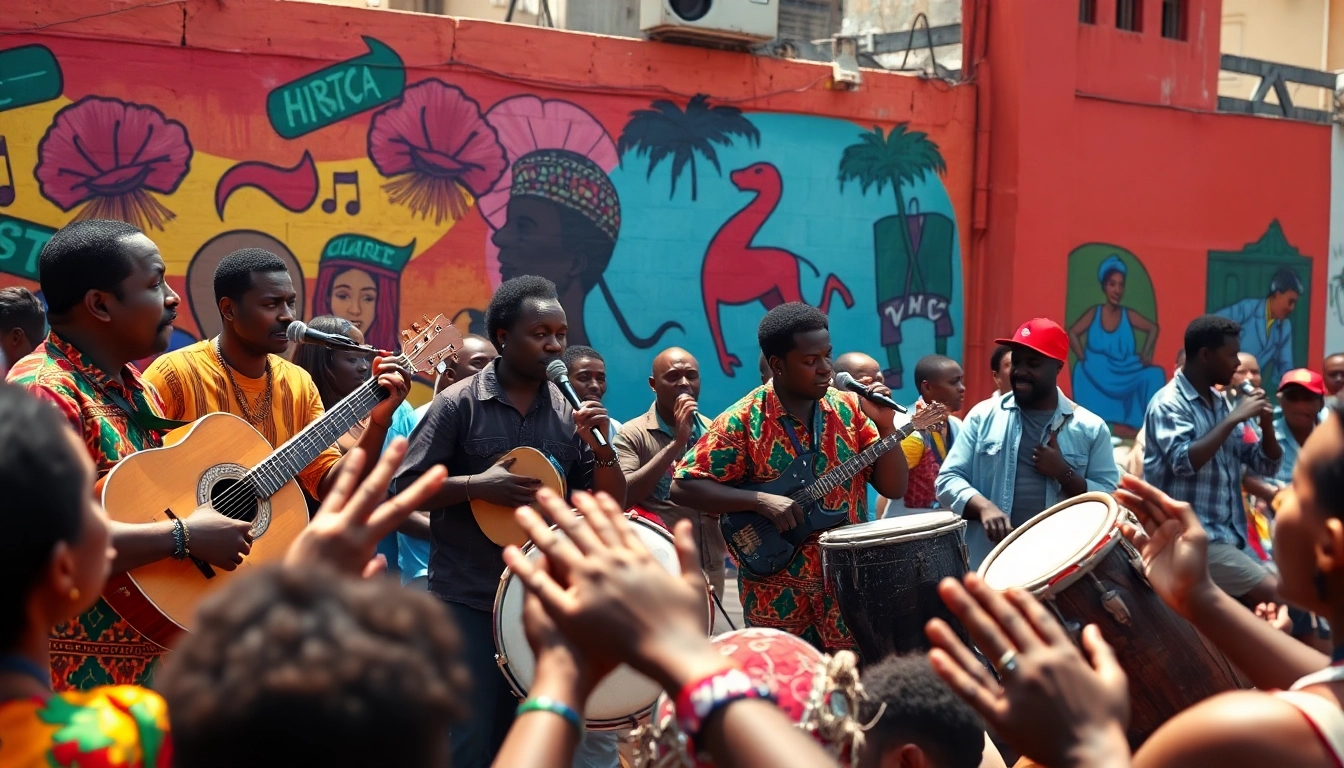The Evolution of African Music Charts
Historical Context of Musical Trends
Understanding the African music charts requires delving into the historical context of musical trends across the continent. African music has its roots deeply embedded in diverse cultures, traditions, and languages. From the rich, rhythmic sounds of traditional drumming to the contemporary beats of Afrobeats and Amapiano, each genre tells a story that reflects not only the musical evolution but also the societal changes within different communities. The transition from traditional to modern music saw significant influences from colonial histories, globalization, and the late 20th century’s technological advancements.
Early African music was predominantly oral, conveying stories and cultural beliefs through communal practices. It was not until the introduction of recording technology in the 20th century that African musicians began to reach wider audiences, allowing their music to be preserved and distributed. This period marked the birth of several music scenes, particularly in urban centers like Lagos, Nairobi, and Johannesburg, where diverse musical styles began to merge, leading to the creation of new genres.
Impact of Technology on Music Distribution
The late 20th and early 21st centuries brought about a technological revolution that fundamentally altered the landscape of music distribution. The rise of the internet and digital platforms transformed how music was produced, distributed, and consumed. In Africa, mobile technology played a crucial role, as many people began accessing music via their phones rather than traditional media. This shift allowed for unprecedented access to a variety of music styles, which in turn began to influence the African music charts.
Streaming services have further revolutionized music distribution. Platforms like Spotify, Apple Music, and increasingly localized services have enabled artists to reach global audiences while allowing listeners to discover new music easily. This democratization of music consumption has allowed grassroots artists to break into mainstream culture without the need for traditional record labels. However, it has also led to challenges regarding music monetization and artist representation on these platforms.
How Charts Reflect Cultural Movements
The African music charts are not just a representation of what is popular at a given moment; they also reflect broader cultural movements and societal sentiments. For instance, genres such as Kwaito and Gqom emerged during specific socio-political contexts in South Africa, serving as anthems for youth resistance and expressing the realities of urban life. Likewise, Afrobeats has grown into a global phenomenon, echoing narratives of identity, resilience, and the African diaspora’s experiences.
Charts often capture transitional periods in society, indicating changes in social attitudes, political climates, and cultural aspirations. For example, artists who tackle issues such as corruption, social injustice, or human rights often see their music resonate strongly, leading to high chart placements. As societal norms continue to evolve, the music reflected in the charts is likely to change, showcasing a continuous dialogue between artists and their listeners.
Understanding Current African Music Charts
Key Metrics Used in Chart Rankings
Chart rankings are determined using various metrics that provide insight into music popularity and consumption patterns. The most common metrics include sales figures, streaming numbers, radio airplay, and social media engagement. This blend of quantitative data captures not only the commercial success of a track but also its cultural relevance and listener engagement.
Streaming has become the dominant metric in recent years, driven by the rise of digital platforms that enable massive sharing of music worldwide. This change has rendered traditional metrics such as sales less significant, as audiences globally interact more with music through streaming services. Charting algorithms now factor in real-time data from social media interactions, allowing for a more dynamic and responsive representation of what resonates with listeners.
Popular Genres Featured in the Charts
The African music charts showcase a rich tapestry of genres reflective of the continent’s diverse musical landscape. Among the most prominent genres currently topping the charts are Afrobeats, Amapiano, Hip-Hop, and Reggae.
Afrobeats has exploded in popularity, known for its infectious rhythms and danceability. Its global appeal has grown, with artists collaborating internationally to produce tracks that transcend borders. Amapiano, characterized by its soulful piano melodies and unique percussive elements, has become an integral part of South Africa’s music scene, continuously influencing mainstream music across the continent.
Hip-Hop remains a powerful genre that often serves as a voice for the youth, addressing contemporary social issues and personal narratives. Meanwhile, Reggae, with its roots in Jamaican culture, has maintained a strong presence in Africa, especially in countries like Ghana and Tanzania, where it melds with local sounds to create distinctive experiences.
Noteworthy Artists Dominating the Scene
The current landscape of the African music charts is dominated by several notable artists who have shaped and defined modern African music. Artists such as Burna Boy, Wizkid, and Tiwa Savage from Nigeria; A-Reece and Nasty C from South Africa; and Diamond Platnumz from Tanzania have not only topped charts but have also gained international acclaim.
Burna Boy, for instance, has achieved global recognition, winning numerous awards and collaborating with international stars, thus showcasing the potential of African talent on the world stage. Similarly, Wizkid’s collaborations and hit singles have established him as a defining figure in Afrobeats, further necessary to understanding the genre’s global impact. These artists represent a generation that is breaking barriers and redefining success in the music industry.
The Role of Streaming Platforms in African Music Charts
How Streaming Shapes Music Popularity
Streaming platforms have profoundly transformed how music is produced, consumed, and distributed across Africa. They provide artists with direct access to their audience and eliminate traditional barriers often posed by record labels and physical sales. The metrics derived from streaming are now integral to the African music charts, reflecting real-time popularity and listener engagement.
As streaming services become more accessible, they are reshaping genre popularity based on listener preferences. Artists can receive immediate feedback on their music, allowing them to tailor future releases to meet audience demand effectively. Moreover, collaborative playlists and algorithm-driven recommendations enable lesser-known artists to gain exposure alongside major stars, creating a more diverse listening experience.
The Influence of Social Media on Chart Success
Social media has emerged as a critical tool for artists and record labels in promoting music and driving engagement. Platforms like Instagram, TikTok, and Twitter allow artists to connect with fans, share their journeys, and promote their new releases in a way that was previously unseen. This engagement leads to increased streaming and sales, directly impacting the African music charts.
For example, viral dance challenges on TikTok have propelled songs to chart-topping statuses overnight. When songs like “Jerusalema” became popular through social media trends, they not only marked a high point in chart history but also highlighted how social media shapes listener habits. The intersection of music and social media has created a platform for global exposure, allowing local hits to resonate worldwide.
Case Studies of Breakout Hits
Analyzing breakout hits provides valuable insights into the evolving trends within the African music charts. Songs like “Jerusalema” by Master KG and Nomcebo Zikode demonstrate how grassroots campaigns can lead to international acclaim. Initially local, the song gained momentum through social media, dance challenges, and widespread radio play, ultimately charting beautifully across numerous countries.
Another notable example is “El Mundo” by the Amapiano collective, which saw a sudden rise on the charts after virally trending on social media. The unique collaboration between various artists showcased how Amapiano has become a cultural movement. These examples highlight the importance of adaptability and audience engagement for artists seeking chart success in today’s music landscape.
Challenges Facing African Music Charts
Barriers to Entry for Emerging Artists
Emerging artists in Africa face several barriers that can hinder their ascension on the African music charts. Lack of access to resources, funding, and exposure means that many talented musicians struggle to break into the mainstream. While digital platforms have democratized music distribution, not all artists possess the tools or knowledge to utilize these resources effectively.
Additionally, the competition on streaming platforms is fierce, with countless new releases flooding the scene daily. Artists must find innovative ways to distinguish themselves, whether through unique sound, visual branding, or engagement strategies. Developing a robust marketing and promotion strategy is essential for new artists to navigate these challenges and find their place in the ever-evolving music market.
Geographical Disparities in Music Representation
Geographical disparities pose another significant challenge to the African music charts and the representation of diverse musical styles. While major cities often dominate the music scene, artists from rural or less-accessible regions may struggle to gain visibility and recognition. These disparities can lead to an undersampling of unique sounds that represent various cultures and experiences across the continent.
Initiatives aimed at promoting local music and grassroots artists are essential for addressing these disparities. By supporting regional talent and encouraging local music festivals and showcases, the music industry can help bring untapped talent to the forefront, enriching the diversity of the charts and broadening the understanding of African music as a whole.
Quality Control and Chart Ranking Integrity
As the African music charts evolve, maintaining integrity in ranking systems presents a complex challenge. The openness of streaming and social media can make charts susceptible to manipulation through deliberate streaming or engagement tactics. This presents concerns regarding authenticity and the true representation of popular music.
Addressing these concerns requires a collaboration between stakeholders in the music industry, including streaming platforms, artists, and charting organizations. Establishing clearer guidelines and standards for chart eligibility and performance metrics can help preserve the integrity of rankings while ensuring that deserving artists receive the recognition they deserve.
The Future of African Music Charts
Emerging Trends to Watch
Looking ahead, several emerging trends are likely to shape the future of the African music charts. One prominent trend is the rise of genre blending, with artists experimenting across various styles to create unique sounds that resonate with diverse audiences. This evolution signals a departure from traditional genre classifications and opens avenues for exploration and innovation in African music.
The incorporation of technology, particularly AI-driven music production and marketing tools, is another trend to watch. These technologies can help artists gain insights into audience preferences, optimize their promotional strategies, and produce music that resonates with listeners’ evolving tastes. As technical resources become more accessible, artists may find themselves empowered to take more creative control over their music.
Predictions for the Next Big Stars
Identifying potential future stars within the African music charts requires an understanding of current music trends and emerging talent. The industry is rife with newcomers who blend distinct cultural influences and innovative sounds, often rising quickly within the digital realm. Artists who understand and actively engage with their audience will likely succeed in making their mark on the charts.
Moreover, collaborations between established and emerging musicians are expected to continue driving chart success, with established artists providing platforms for new talent to amplify their reach. As collaborations become increasingly common, audiences can look forward to a diverse musical landscape marked by creativity and dynamism.
The Globalization of African Music and Its Charts
The globalization of African music has significantly impacted the African music charts, with a growing interest from international audiences. This cross-continental exchange fosters cultural appreciation and showcases the rich musical heritage present in African countries. The interest also encourages investment and collaboration, enabling artists to expand their reach beyond the continent.
As African music continues to gain traction globally, its influence on international music styles will foster a cycle of innovation that melds various sounds, leading to richer and more diverse musical expressions. The future of African music charts will likely reflect this dynamism, capturing the pulse of the continent while resonating with audiences worldwide.



